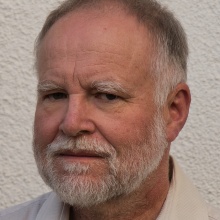Contact
Pfaffenwaldring 29
70569 Stuttgart
Deutschland
Ch. Nöldeke, W. Metzger, R. P. Huebener, and H. Schneider “Exciton Impact Ionization and Electric Conductivity in Germanium at Low Temperatures” Phys. stat. sol. (b), 129 (1985)
H. Seifert and Ch. Nöldeke “Different Types of Intermittent chaos in Josephson Junctions” in: Proceedings of the 17th International conference in Low Temperature Physics (1984)
Ch. Nöldeke and H. Seifert “Different types of Intermittent Chaos in Josephson Junctions –
Manifestation in the I-V-Characteristics” Phys. Lett. 109A, 401 (1985)
Ch. Nöldeke “Chaotic Josephson Scenario in a Sn/SnxOy/Sn Tunnel Junction at 10 GHz” Physics
Letters A, 112A, 178 (1985)
Ch. Nöldeke „Chaotisches Verhalten beim Josephsoneffekt” Dissertation, Tübingen (1986)
Andrew MacGregor, Bruno Dion, Christoph Nöldeke, Olivier Duchmann ”39 photont/bit direct
detection receiver at 810 nm, BER=1x10-6, 60 Mb/s QPPM“ SPIE Vol.1417 Free Space Laser
Communications Technologies III (1991)
Michael Alberty, Martin Clostermann, Bernd Hespeler, Ulrich Hildebrand, Peter Greulich, and
Christoph M. Nöldeke “Direct detection optical intersatellite communication - SILEX communication
equipment - Status and further perspective”, 15th International Communicatons Satellite Systems
Conference and Exhibit, (1993)
Christoph M. Nöldeke “Air interface and payload architecture for GEO multimedia
communications satellites” Space Communications, vol. 17, no. 1,2,3, pp. 49-58, 2001
Paolo Proietti Zolla, Norbert Nathrath, Christoph Noeldeke, Marco Formaggi, Glafkos
Philippou, Christoph Tschepe, Nelson Fonseca “A Q/V-band Antenna for Feeder Link Applications” 8th
European Conference on Antennas and Propagation (EuCAP 2014)
Ch. Nöldeke, P. Proietti Zolla, M. Lori, N. Fonseca “Herausforderungen für die Anbindungen
von Ankerstationen für Satellitennetze höchsten Durchsatzes im Q/V-Band: Ausbreitung,
Bodenstationsabstand und geografische Fairness” 4. Nationale Konferenz - Satellitenkommunikation in
Deutschland", Bonn, 2015
Christoph M. Nöldeke "Satellite Communications" Lehrbuch zur Vorlesung, MV-Wissenschaft
(2011)
Christoph M. Nöldeke "The Space Radiation Environment" Lehrbuch zur Vorlesung,
MV-Wissenschaft (2015)
Böttcher, Ch. M. Noeldeke, S.Klinkner „Flexible Transmit Arrays for Regional Coverages in Ka-Band“ 39th ESA Antenna Workshop on Multibeam and Reconfigurable Antennas for Space Applications”, October 2018
O. Reichmann, P. Proietti Zolla, M. Lori, T. Würfl, F. Triberti, H. Garcia-Hemme, E. K. Pfeiffer, A. Ihle, C. Schöppinger, C. Nöldeke "A Multibeam Q/V-band Reflector for Terabit Satellite Applications” “ 39th ESA Antenna Workshop on Multibeam and Reconfigurable Antennas for Space Applications”
Ch. Noeldeke, M. Boettcher, U. Mohr, S. Gaisser, M. Alvarez Rua, J. Eickhoff, M. Leslie, M. Von Thun, S. Klinkner, R. Varatharajoo,
„Single Event Upset Investigations on the “Flying Laptop” Satellite Mission“
Advances in Space Research, Volume 67, Issue 6, 2021, Pages 2000-2009, ISSN 0273-1177,
https://doi.org/10.1016/j.asr.2020.12.032.
1956
Geboren in Pforzheim
1975-1983
Studium der Physik an der Universität Tübingen
Okt. 1976-Januar 1978
Zivildienst
1983-1986
Wissenschaftlicher Angestellter am Physikalischen Institut der Universität Tübingen
Feb. 1986
Promotion über „Chaotisches Verhalten beim Josephsoneffekt“, Doktorvater Prof. Dr. Rudolf
Hübener
1986
Eintritt bei ANT Nachrichtentechnik GmbH, Backnang, Produktbereich Raumfahrt als
Entwicklungsingenieur
1991-1997
Leiter der Gruppe Digitalgeräte (bis 1996: Optoelektronische Geräte) im Produktbereich
Raumfahrt
2001-2005
Entwicklungsleiter bei Selenia Communications GmbH, Backnang
2005-2009
Gruppenleiter "Subsystem Engineering" bei Tesat Spacecom GmbH&Co. KG, Backnang
2010-2020
Wissenschaftlicher Experte für Kommunikationssysteme der nächsten Generation bei Tesat
Spacecom GmbH&Co. KG, Backnang
Seit 2011
Lehrbeauftrager an der Universität Stuttgart am Institut für Raumfahrtsysteme für „Satellite
Communications“ und „Space Radiations“
Mitbetreuung von Abschlussarbeiten
Wissenschaftlich-technische Beratung bei der Entwicklung von Kleinsatelliten wie „Flying
Laptop“ und „Source“
Feb. 2020
Bestellung zum Honorarprofessor


